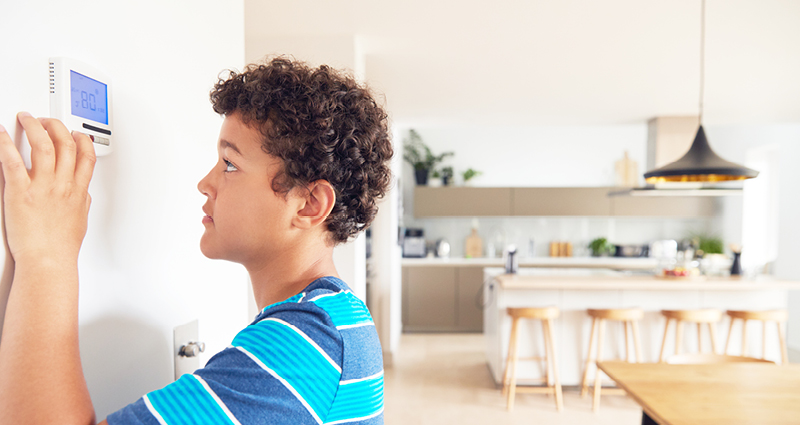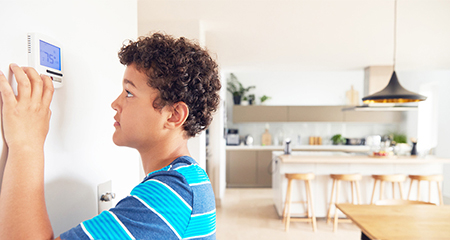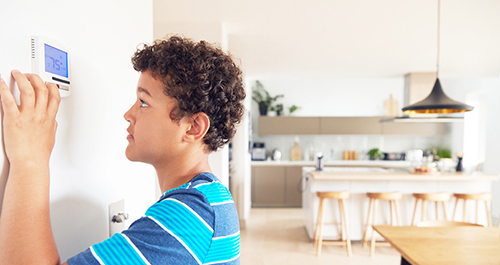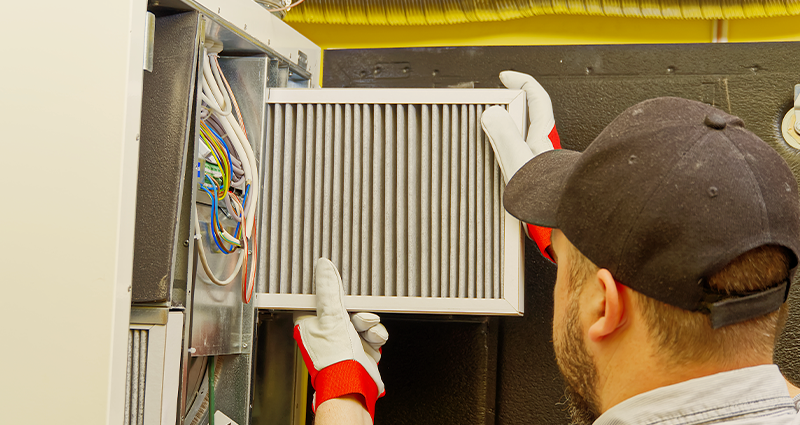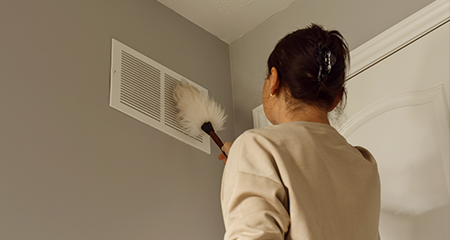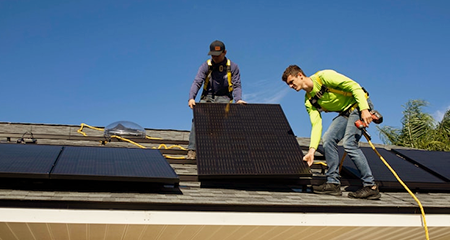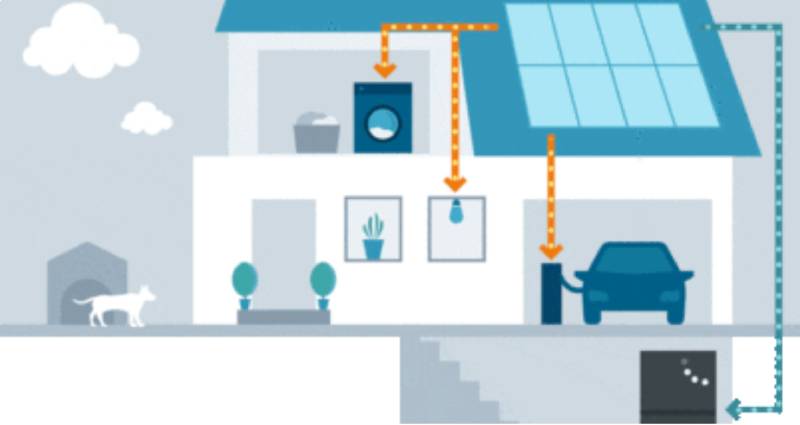Mini-split systems
Mini-split systems absorb heat and produce cool air using the same basic technology as central air, but their design is significantly different. Mini-split systems are mounted on the wall. You’ve probably seen them installed in hotel rooms.
With a mini-split system, you can install one in every room in the house, each with its own wall-mounted evaporator and fan unit. These units then share a single outdoor condenser and compressor unit.
Pros of mini-split systems:
- Zone control: Each evaporator and fan has its own thermostat. So, you can save money by adjusting the temperature higher in unoccupied rooms.
- No ductwork needed: Because there’s no ductwork, mini-split systems may be a more affordable solution for home additions or retrofitting older homes. Plus, you don’t have to worry about your cool air escaping through leaky older ductwork.
- Looks better than window units: The wall-mounted units may be more attractive than window units. And they won’t take up the window and disrupt your views!
Cons of mini-split systems:
- Energy efficiency: Mini-split systems are generally less efficient than central air systems. But you can control temperatures in each room, so you could make up that energy cost by being smart with the thermostats!
- Installation costs: The cost increases with each evaporator unit you install. Installation may also be more expensive than central air, depending on how many rooms you want to cool.
- You can see it: They look better than window units, but mini-split systems don’t offer the nearly invisible cooling of central air. Central air is a better fit if you don’t want to see your cooling equipment.
Window units
Window units are air conditioners you can buy at many hardware and department stores and then install into a window in your house.
Pros of window units:
- Low cost: Window units are significantly less expensive than central air or mini-split systems and don’t need professional installation.
- Affordable efficiency: Splurging on a highly-efficient window unit won’t cost much more than other window ACs but can make a big difference in long-term energy savings.
- Flexibility: Window units can be placed anywhere with an exterior window and an electrical outlet within reach.
Cons of window units:
- Aesthetics: Window units obstruct your view of the outdoors and drip condensation below. This deters a lot of people from window unit air conditioners.
- Noise: Because the components are practically in your living space, expect window units to be louder than central air or mini-split systems.
- Warm air infiltration: Improper installation can result in a poor seal around the window unit. That gap can let in warm air and even pests.
- Security concerns: A window with an air conditioner is less secure than one that is closed and locked.
Air conditioner efficiency: choosing the right size
Size matters when shopping for a new air conditioner, regardless of the type. We’re not talking about just it’s physical size. The size also refers to the unit’s cooling power, usually measured in British Thermal Units (BTU). Size is essential for several reasons.
Sizing a central air conditioner or mini-split system
If an AC is too small, it will run constantly to keep the large space cool. The constant operation will drive up your energy bill and cause wear and tear on the system. The added strain can cause premature breakdowns and costly repairs and shorten your air conditioner’s lifespan.
If the AC is too large, it can cool the house too quickly! So what, why does that matter? Well, air conditioners also dehumidify the air in the room while cooling it, and you can’t speed up that dehumidification process. Installing an oversized AC will leave that extra moisture behind, and your air will feel damp and clammy.
When buying a central air conditioner or mini-split system, an experienced HVAC company will measure your home and recommend an AC that is the right size for your space. Make sure they do! These AC systems are a significant investment that requires professional installation. You want the exact size calculation to get the best return on that investment.
Sizing a window unit air conditioner
Window unit air conditioners are 100% a do-it-yourself solution. You’ll install it yourself, and you’ll have to calculate the size of the unit yourself, too. Don’t worry, it’s not hard!
First, measure the dimensions of the room you want to cool. Then, use this ENERGY STAR chart to see how many BTUs you need to cool it efficiently. Take note of the tips to adjust the BTU count if the room you're cooling is shady, sunny or a kitchen.
How to choose the right energy-efficient air conditioner
It pays to choose an energy-efficient air conditioner, so how can you ensure you get a good one? Pay close attention to the product labels.
Window units
All new window units come with an EnerGuide label. This label tells you how much energy the model uses. If it’s an especially efficient model, it will also have an ENERGY STAR symbol.
EnerGuide Label
The EnerGuide label helps you compare AC models. You’ll likely see information about how much energy the model uses in kilowatt-hours and how it compares with other more efficient and less efficient models.
ENERGY STAR Symbol
An ENERGY STAR-certified window unit uses 10% less energy than a standard model. Choosing an ENERGY STAR-certified AC will help you lower your energy bills. Here are some things to know about ENERGY STAR-certified window units:
- Window units earn the ENERGY STAR symbol based on their Combined Energy Efficiency Ratio (CEER).
- The higher the CEER, the more energy-efficient the unit.
- The minimum CEER needed to qualify for ENERGY STAR certification depends on the unit size, but it ranges from about 12 for smaller units to about 10 for larger units.
You can browse certified units on the ENERGY STAR website.
Central Air Conditioners
Central air conditioners use the Seasonal Energy Efficiency Ratio (SEER), which is similar to CEER. Here are some things to know about SEER.
- The higher the SEER, the greater the efficiency.
- Central ACs with a SEER of 15 or greater qualify for ENERGY STAR certification.
- ENERGY STAR-certified central air conditioners use 8% less energy on average than non-certified systems.
Working with a reputable and professional air conditioning company will ensure you get the proper central air conditioning for your needs. They’ll explain the difference between certified units and SEER ratings and offer knowledgeable guidance.





















